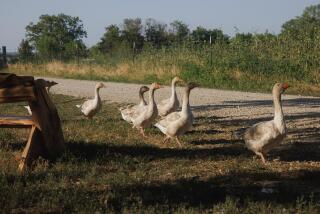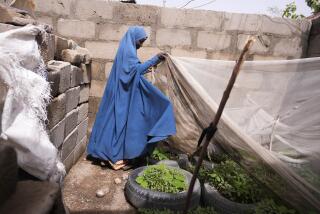Fund Drought Perils Effort to Boost India Crops
PATANCHERU, India â Working with humble cereals and lentils long ignored by science, agricultural researchers in the Indian heartland have helped relieve famine in Asia, revolutionize diets in Latin America, revive agriculture in war-torn Africa.
Now, a quarter-century after the International Crops Research Institute for the Semi-Arid Tropics began its search for new farming methods and crop varieties to help the worldâs hungry, some people fear its work could be in jeopardy.
Budget pressures in Western donor nations have reduced financing for the institute and similar centers, and that has meant cutbacks in research.
The institute has made all the difference for farmers like Yerram Naidu, who has a five-acre peanut field in the southern Indian state of Andhra Pradesh.
Once, black caterpillars smothered his peanut plants every summer, devouring the leaves. Naidu zapped them with strong pesticides, but the chemicals seeped through his thin cotton face mask, giving him violent headaches. The pesticides also killed beneficial bugs, poisoned frogs, lizards and birds and polluted ground water.
Six years ago, Naidu related his woeful tale to a fellow passenger on a long bus ride. His companion happened to be a scientist at the institute.
The scientist advised Naidu to switch to a disease-resistant peanut strain that the institute had developed. He also invited him to visit the instituteâs campus to learn organic farming techniques.
âThat meeting changed my life,â Naidu said, sitting on a string cot outside his two-room concrete house in a village near the instituteâs headquarters in Patancheru, 35 miles northwest of Hyderabad, the state capital.
âMy headaches are gone. My crop yields have increased. I get more money,â he said, looking out at buffaloes, chickens and goats roaming amid the farm implements.
The institute began in Patancheru 25 years ago with money from the Consultative Group on International Agricultural Research, a group of 50 public and private donors like the United Nations and the World Bank. It later added six research stations in Africa.
The researchers focused on the semi-arid tropical regions of Africa, South Asia and parts of Latin America that are home to a sixth of the worldâs people.
Hunger was rampant in such regions. People got less than 2,400 calories of food a day, short of the 2,800 calories the United Nations considers the minimum necessary for good health.
Crop yields were low. Soils were stripped of nutrients. The weather was unpredictable. Farmers didnât use fertilizers and pesticides, or applied them incorrectly, and depended entirely on rain.
The scientists decided they could eradicate hunger by improving six humble cereal and lentil crops--sorghum, pearl millet, finger millet, peanuts, chickpeas and pigeon peas--that are the staple diet of people in the semi-arid tropics.
âUnlike wheat and rice, it was not prestigious to do research on sorghum or millets,â said James Ryan, director of the institute. âNobody would touch them. They were orphan crops.â
The center collected seeds from around the world, cataloged their qualities and worked with American universities to produce new varieties tailored to different climates, soil and socioeconomic needs. The results were huge increases in yields.
Without the crop varieties developed at the institute, the world would need an additional 100 million acres of farmland to produce the same amount of food, Ryan said.
âOn the question of value for money, benefits, power and environment, the answers are resoundingly positive,â he said. âFor every dollar invested in research, we have found that it pays back seven dollars. The lowest rate of return is 20%; the highest, about 300%.
The institute now has the worldâs largest collection of seeds--111,000 varieties of six crops--stored in refrigerated vaults in earthquake-resistant buildings.
During the recent civil war in Rwanda, farmers consumed the last supplies of sorghum to stave off hunger and were left with no seeds when peace returned. Scientists at Patancheru thawed the seeds they had collected years ago from the African country and rapidly multiplied them in the instituteâs fields.
âThese were the seeds of hope, the seeds of freedom. The germ plasm [seed] collection is a national insurance policy for countries,â Ryan said.
The seed bank helps scientists produce new breeds by choosing specific qualities such as resistance to disease or to drought.
In India, scientists nearly halved the growth period for pigeon peas, an important source of protein, enabling farmers to raise a second crop.
âIt was a major step in increasing protein availability to the masses,â Ryan said.
But the institute has had to reduce its staff and research because of reductions in aid from the West.
G. Balachandran, an Indian economist, finds the aid cuts shortsighted.
âResearch in agriculture takes 10 to 15 years to yield results,â Balachandran wrote in a review of the instituteâs work. âUnless these institutes are strengthened, the world may have to face severe food shortages in the years to come.â
More to Read
Sign up for Essential California
The most important California stories and recommendations in your inbox every morning.
You may occasionally receive promotional content from the Los Angeles Times.










